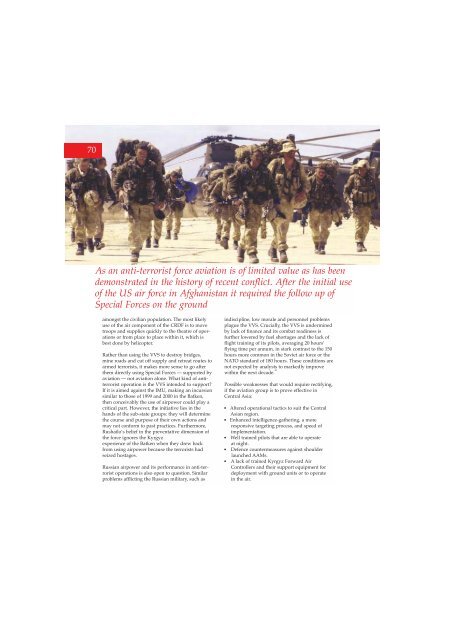Volume 6 No 4 - Royal Air Force Centre for Air Power Studies
Volume 6 No 4 - Royal Air Force Centre for Air Power Studies
Volume 6 No 4 - Royal Air Force Centre for Air Power Studies
Create successful ePaper yourself
Turn your PDF publications into a flip-book with our unique Google optimized e-Paper software.
70<br />
As an anti-terrorist <strong>for</strong>ce aviation is of limited value as has been<br />
demonstrated in the history of recent conflict. After the initial use<br />
of the US air <strong>for</strong>ce in Afghanistan it required the follow up of<br />
Special <strong>Force</strong>s on the ground<br />
amongst the civilian population. The most likely<br />
use of the air component of the CRDF is to move<br />
troops and supplies quickly to the theatre of operations<br />
or from place to place within it, which is<br />
best done by helicopter.<br />
Rather than using the VVS to destroy bridges,<br />
mine roads and cut off supply and retreat routes to<br />
armed terrorists, it makes more sense to go after<br />
them directly using Special <strong>Force</strong>s — supported by<br />
aviation — not aviation alone. What kind of antiterrorist<br />
operation is the VVS intended to support?<br />
If it is aimed against the IMU, making an incursion<br />
similar to those of 1999 and 2000 in the Batken,<br />
then conceivably the use of airpower could play a<br />
critical part. However, the initiative lies in the<br />
hands of the sub-state groups: they will determine<br />
the course and purpose of their own actions and<br />
may not con<strong>for</strong>m to past practices. Furthermore,<br />
Rushailo’s belief in the preventative dimension of<br />
the <strong>for</strong>ce ignores the Kyrgyz<br />
experience of the Batken when they drew back<br />
from using airpower because the terrorists had<br />
seized hostages.<br />
Russian airpower and its per<strong>for</strong>mance in anti-terrorist<br />
operations is also open to question. Similar<br />
problems afflicting the Russian military, such as<br />
indiscipline, low morale and personnel problems<br />
plague the VVS. Crucially, the VVS is undermined<br />
by lack of finance and its combat readiness is<br />
further lowered by fuel shortages and the lack of<br />
flight training of its pilots, averaging 20 hours’<br />
flying time per annum, in stark contrast to the 150<br />
hours more common in the Soviet air <strong>for</strong>ce or the<br />
NATO standard of 180 hours. These conditions are<br />
not expected by analysts to markedly improve<br />
within the next decade. 41<br />
Possible weaknesses that would require rectifying,<br />
if the aviation group is to prove effective in<br />
Central Asia:<br />
Altered operational tactics to suit the Central<br />
Asian region.<br />
Enhanced intelligence-gathering, a more<br />
responsive targeting process, and speed of<br />
implementation.<br />
Well trained pilots that are able to operate<br />
at night.<br />
Defence countermeasures against shoulder<br />
launched AAMs.<br />
A lack of trained Kyrgyz Forward <strong>Air</strong><br />
Controllers and their support equipment <strong>for</strong><br />
deployment with ground units or to operate<br />
in the air.
















